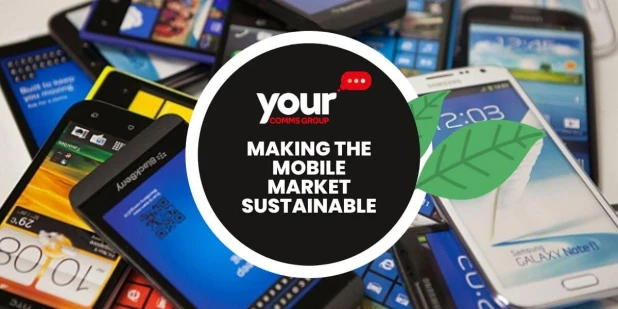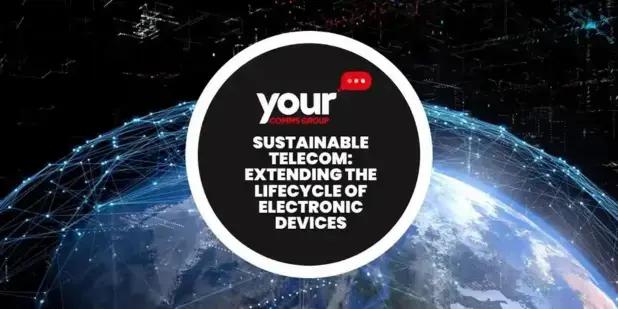Smart Waste Management Systems with IoT
Urbanisation and population growth have challenges, such as the rapid rise in waste, which increases greenhouse gas emissions, pollution, and other...

You’d have to have been living under a rock to have missed the fact that sustainability issues have become a de facto part of decision-making in business. Whether you run a small company employing a handful of people, or a multi-million-pound conglomerate with a global footprint, the question of how to slow, reverse, and then eradicate your carbon footprint is now a strategic cornerstone in everybody’s thinking.
That’s as it should be. Global warming and the impact of business on the environment is a serious issue and one we should all take seriously, not least because our customers certainly do and we’re all under increasing scrutiny from them to make the right environmental choices.

With more than 4.5 billion devices in active use around the world, the smartphone has long been the most popular piece of technology on earth. Not surprisingly, the telecoms industry has been preoccupied for some time with the need to reduce emissions.
On the surface of things, fair progress has already been made with a wide range of sustainability approaches aiming to deliver net zero emissions goals – the new 5G networks are designed to minimise energy usage (and 6G will be more efficient still), most firms are using recycled or recyclable packaging, electric chargers are being slowly phased out, and longer-term strategies will exponentially accelerate that work.
Yet many consumers remain sceptical about whether any of the measures so far announced by the mobile tech firms will make any meaningful difference because as yet there is no simple or straightforward metric by which to measure or quantify their impact.
In short, how much of the sustainability noise coming out of the mobile device sector is tangible, and how much of it is untethered marketing gloss?
Current estimates suggest that the 4.5 billion devices currently active will generate a little under 150 million tons of CO2 or C02 equivalent (CO2e) emissions.
For context, that equates to less than half of one percent of the total global CO2e pumped into the atmosphere in 2021, making the smart device sector arguably less of a contributor to the sustainability problem than some might have thought.

Yet the sector knows that as existing tech is replaced by emerging technology designed to support greater automation through the Internet of Things (IoT), usage will increase, and the associated emissions – for example, the appliances controlled by a mobile device – will add considerably to a carbon footprint that can be traced back to those devices.
One lingering question, then, is whether the measures that are directly within the mobile sector’s control will be enough to offset the indirect emissions of linked technology. And if not, how much responsibility should the sector assume for contributing to a solution?

Obvious opportunities exist to soften the sustainability impact of mobile devices. The manufacturing process is top of the list here, given 95% of a mobile device’s associated carbon emissions are tied up in how it gets to market.
Forward-thinking and smart strategies around the use of recycled materials, reducing reliance on mining by switching to tin, cobalt, or aluminum for electronic components, improving infrastructure efficiency, making use of renewables, and extending device life are all in play for businesses that are serious about their sustainability commitments.
And all of these high-visibility measures will also make those commitments real among the millions of consumers for whom sustainability is becoming increasingly influential in purchasing decisions.
Lifetime longevity is particularly critical in the sustainability story, and as reliability improves within ageing smart devices, manufacturers will have a part to play in moving their customers away from the habit of replacing their phones every one to two years and instead advocating device retention.
This, in turn, will require those manufacturers to innovate around new revenue streams that can replace renewal income.
It will also require an upshift in thinking around homogenising operating systems so that they are backward and forwards compatible – something that will inevitably impact resale values and retention appeal.
In a more sustainable future, it could be that software and hardware innovation can be cross-pollinated, driving technology across multiple product ranges – in turn reducing the capacity requirement for cross-sector and cross-portfolio manufacturing.
By the end of this year, smart mobile devices are forecast to outnumber laptops and PCs by three to one. Technology innovation now around streamlining the process to deliver carbonisation targets will reap significant rewards over the next decade or more.
But it requires collaboration and knowledge sharing – things for which the mobile technology sector isn’t exactly well known. The question is, who will blink first? If you are looking at the best mobile deals currently on the market contact an expert from Your Comms Group today.
Or if your renewal date is not yet due, submit your renewal date here for the latest offers and custom plans 4 weeks before your renewal date.

Urbanisation and population growth have challenges, such as the rapid rise in waste, which increases greenhouse gas emissions, pollution, and other...

In our increasingly connected world, the telecom industry plays a pivotal role in keeping us in touch with loved ones, facilitating business...

Industrial waste management has always been a complicated process that consumes many resources. Conventional methods usually involve laborious...